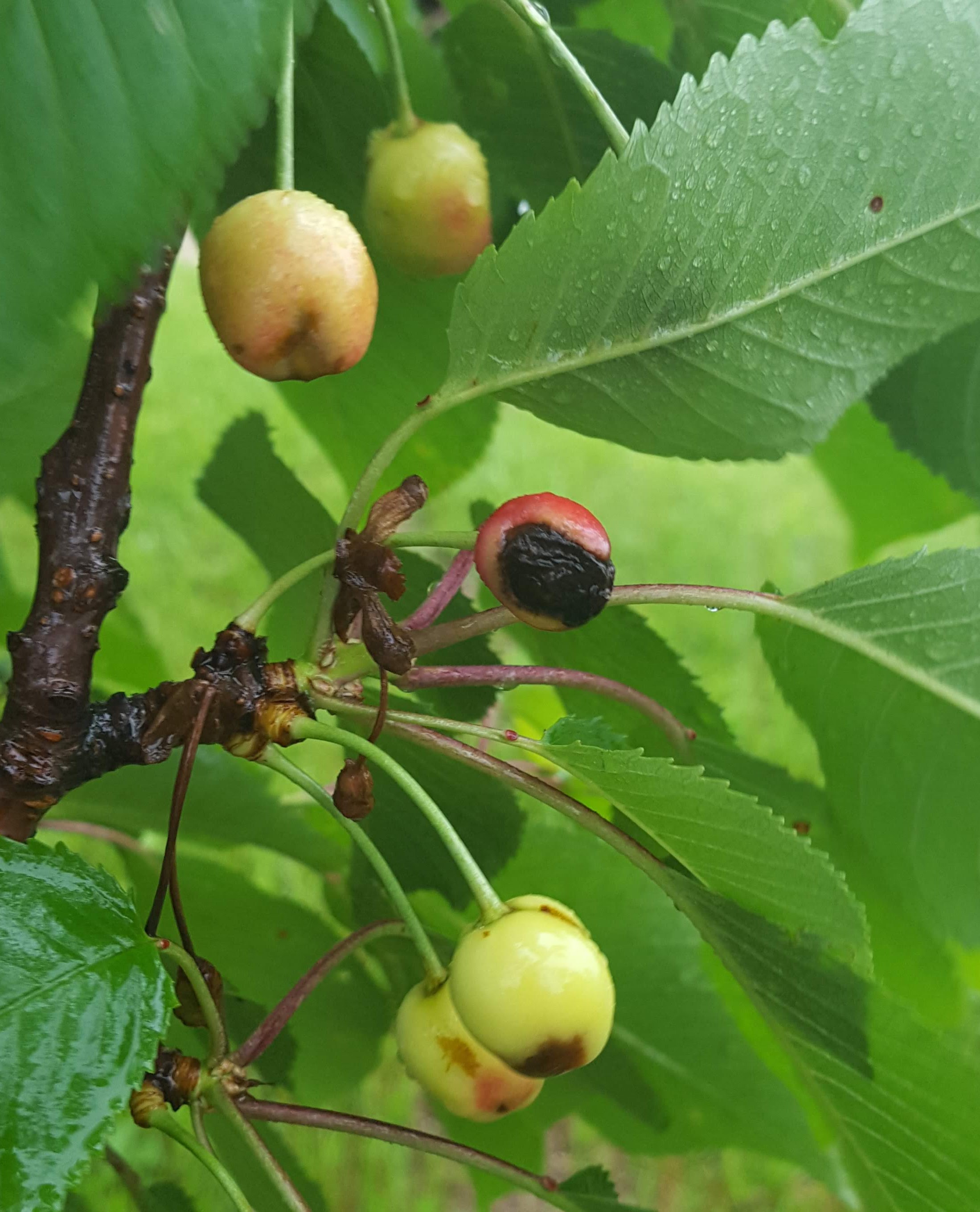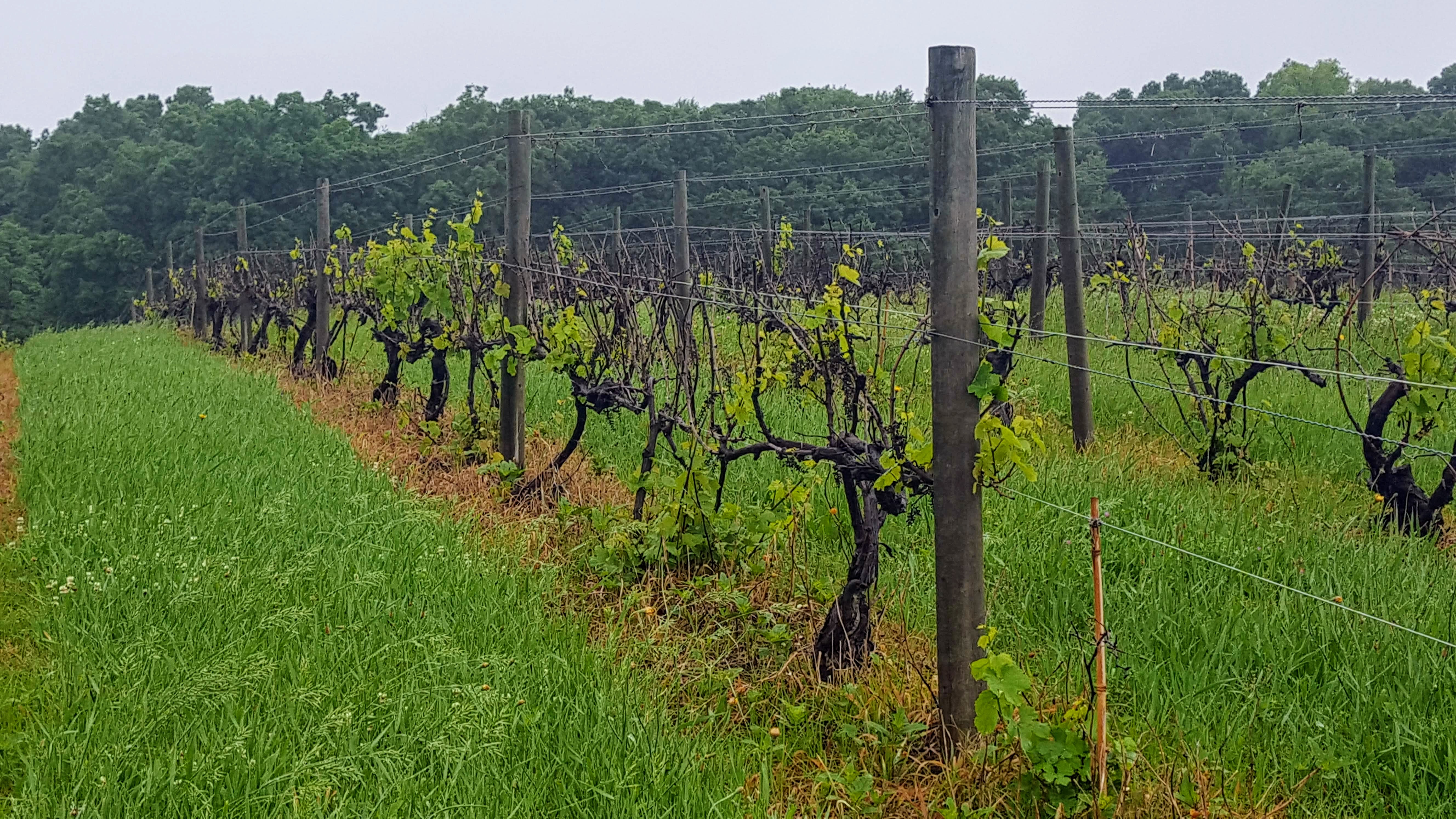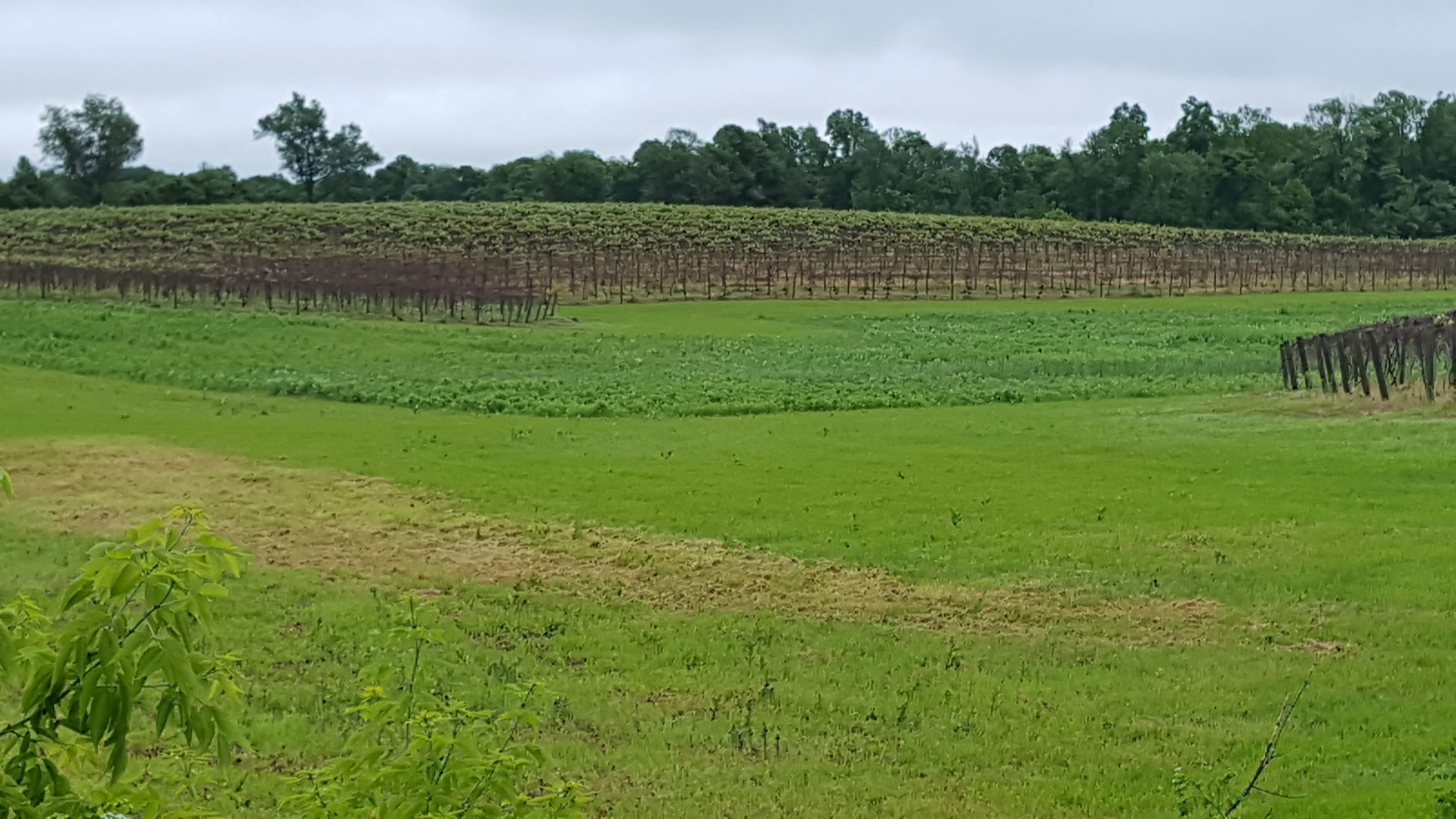Southwest Michigan fruit update – June 11, 2019
Strawberry harvest is beginning. Grapes will bloom soon.

Weather
Last week was our warmest week this year with high temperatures around 80 degrees Fahrenheit. Showers moved across the region Wednesday, June 5, and Sunday, June 9. Low temperatures were in the 60s.
Precipitation totals for the week ranged from 0.76 to 2.4 inches. Berrien County received the most rain. Rainfall totals for the season are 9 to 12 inches across the region since April 1.
The forecast for this week is for cool conditions, with highs in the 70s and lows in 50s. This is cooler than normal for this time of year. There is a good chance of rain on Thursday, June 13.
Sandy soils are beginning to dry out, but heavier soils are still wet. Soil temperatures are in the 60s. There is still standing water in poorly drained fields and wet spots.
With the warmer temperatures, we picked up about 165 growing degree days (GDD) base 42 and 111 GDD base 50. Locations away from Lake Michigan are picking up heat units faster than those close to the Lake. We now less that week behind normal heat accumulation for the season. Growers can expect the cool wet weather to continue this week.
|
Southwest Michigan GDD Summary from March 1 through June 9, 2019 | |||
|---|---|---|---|
|
Station |
GDD 42 F |
GDD 45 F |
GDD 50 F |
|
Benton Harbor (SWMRC) |
888 |
708 |
467 |
|
Lawton (Lawton) |
924 |
741 |
496 |
|
Fennville (TNRC) |
772 |
605 |
386 |
|
Average for the SW region |
900 |
720 |
477 |
|
Accumulation last week |
165 |
144 |
111 |
Check out the new animated weather forecasts from Jeff Andresen at the weather tab in the Michigan State University Extension Fruit & Nuts Page. Articles and other regional reports can be found at the Fruit News page.
Tree fruit
June drop is ending and the apple thinning window is closing. Winter injury is present in many blocks. Injured plants have poor growth and some limbs are collapsing. Given the severe winter cold, winter injury in many cases is less than we expected. In only a few cases do we see wide spread winter injury across many vineyards, orchards or fields but mainly in low spots or as isolated plants in a planting.
The warm weather last week caused a jump in insect activity over the previous week and there was a strong flight of many moth pests. The Trevor Nichols Research Center trap line has caught male San Jose moths for the past two weeks, with a biofix of June 3. Estimated first crawlers 375 GDD51 after biofix, or approximately 757 GDD51 after Jan. 1 for the Southwest Michigan Research and Extension Center (SWMREC) weather station, about the end of June. If Movento is used for crawler control, it should be applied at least a week before crawler emergence is expected.
Apricots fruit are about an inch in diameter.
Peach and nectarine fruit are up to 19 millimeters in diameter and big enough to attract tarnished plant bug and plum curculio. First catch of oriental fruit moth was on May 6 at the Trevor Nichols Research Center, and the flight has been ongoing since then. Shoot flagging due to oriental fruit moth entries should show up soon. It is time to put on larval controlling insecticide sprays to protect developing tree shoots. More trunk cracking is being reported, presumably due to the January low temperatures. Damaged trunks and weakened trees can be especially attractive to borers. Pheromone disruption for protection against peach tree borers should be out soon, if this is the chosen method for control. In peaches at some locations, the foliage seems pale as if they are short of nitrogen, but we think this is due to the cool conditions and the trees should respond to warmer temperatures.

Sweet and tart cherry fruit growth has paused for pit hardening and seed development (Stage II). The fruit are the same diameter as last week with sweet cherries are 13 millimeters in diameter and tart cherries are 11 millimeters. The pits are hard and it looks like June drop is finished. We expect to move into Stage III, fruit swell and ripening soon. The fruit are attractive to plum curculio egglaying and feeding, with some damage noted two weeks ago. Growers may need to reapply insecticides.
Cherry leaf spot management is needed. We have had many wetting periods since bloom, in some locations only a few have been warm enough to be cherry leaf spot infection periods. Other locations have had many more infections, which were warmer or longer. Fruit symptoms of bacterial canker have also been found in sweet cherries.
The plum crop is light for most sites. Japanese plums are 22 millimeters and European plums (Castleton) are 20 millimeters diameter in central Berrien County. We are seeing shot holing of the leaves and russeting of the fruit. This may be due to an interaction between our cool wet conditions and fungicide sprays. Young plum fruit and foliage are tender and are prone to russeting from captan, especially under cool, slow drying conditions.
Apple fruit are growing rapidly. Gala, Golden Delicious and Red Delicious king fruit range from 22 to 18 millimeters, Honeycrisp is 15 to 26 millimeters and Zestar are up to 29 millimeters in diameter. Smaller apples are about 12 millimeters and some have yellow stems indicating they will fall. June drop is underway. With high temperatures forecast to be in the 70s this week, the trees will not be stressed. Use the Cornell carbohydrate thinning model to estimate the susceptibility of apple fruit to chemical thinning sprays and adjust thinning rates according. Once apples are larger than 18 millimeters in diameter, they become hard to thin effectively.
The Enviroweather Maryblyt model indicated symptoms for infections on May 25 and 27 should be appearing now. Apogee is an option now for reducing the susceptibility of apple shoot growth to the internal spread of fire blight. The rate depends on the variety and age of tree.
Apple scab ascospore trap catches have been relatively low for the last few wetting periods indicating that the end of scab season is at hand. Look for scab lesions on the leaves and fruit to decide if you can drop fungicides from your upcoming cover sprays. The Enviroweather sooty blotch and flyspeck model indicates spray applications for these diseases can be delayed due to cool conditions.
Codling moth biofix was set for some orchards in the region on May 28 during the warm Memorial Day weekend. Trap catches declined the following week and then rebounded last week when many orchards caught their first moths and set a biofix. This highlights the importance of trapping individual sites rather than depending on a regional biofix set at a distant site. Egg hatch is predicted to begin later this week, based on a May 28 biofix in central Berrien County. Mating disruption dispensers need to be up where this management option is being used. There are many different options for controlling the first generation of codling moth. Plum curculio monitoring should also be in place. A few colonies of rosy aphids are being detected in Golden Delicious leaves.
Pear fruit are sizing. Bartlett and Harrow Sweet fruit are 19 millimeters. The first generation codling moth is not a problem in hard pears but plum curculio can and will lay eggs in pears. The time of rapid shoot growth with succulent leaves is the primary treatment window for pear psylla. This treatment window is rapidly closing.
Small fruit
We have been catching spotted wing Drosophila (SWD) is the region. Set out traps to monitor this pest. Controlling this pest is focused on ripen fruit. Sometime the earliest fruit of the season such as strawberries, early summer raspberries and early season blueberries can be harvested before this pest builds to high numbers. Do not assume this pest will pass by. Monitor early ripening wild fruit near your fruit planting so you have an idea of the local population. If SWD numbers are high, monitor your fields and be prepared to spray to protect ripening fruit. See: Plan to change when dealing with spotted wing Drosophila.

Grapes moved quickly. Shoots are 12 to 18 inches long. Flower buds are separating in the cluster. With cool conditions this week, we expect bloom in about a week. Growers will focus their pre-bloom spray on disease management before bloom. The bloom sprays are the most important sprays for controlling diseases on the berries. Use materials or a mix of fungicides to control all the major fruit diseases, downy mildew, phomopsis, powdery mildew and black rot, which can infect new green tissue as it is exposed.

Wild grapes have been blooming for a week. We are catching grape berry moth. Bloom in wild grapes is used to set the grape berry moth model on Enviroweather and determine the spray timing for treating the second and third generations of this pest. Wild grape bloom began about May 31 in central Berrien County and June 1 in Van Buren County. Rose chafer should appear soon.
Blueberries are past bloom. There is a wide variation in berry size. The larger berries are 8 to 10 millimeters in diameter. Bloom continues in fields located to the north or closer to the Lake. Bloom looked good across the region.
Cherry fruitworm and cranberry fruitworm have both been caught, but trap catches were sporadic and few sites had set a biofix. The warm weather this last week caused a good moth flight. Cherry fruitworm biofix for the region was set as June 3 and egglaying has begun. Cranberry fruitworm GDD biofix is predicted for this coming week. Blueberry stem gall wasp is also flying. This is a major pest in Ottawa and Allegan counties and is becoming more common in northern Van Buren County. Chemical sprays may be necessary in susceptible varieties such as Jersey and Liberty. Time insecticide sprays a week apart and make sure to add 1% summer oil to help with stem penetration.
.jpg)
The disease focus is on anthracnose as the small green fruit is very susceptible to infection, which does not appear until the fruit begins to ripen. Tailor your green fruit fungicide choice to control anthracnose under these cool wet conditions
Strawberry fruit are changing color and sizing. Berries grown on plastic are being harvested. Harvest of strawberries from conventional matted row plantings has begun in southern fields and should become widespread in the region this week. The cool weather could make for a good crop with good size and quality, without hot temperatures pushing fruit ripening and shortening the season. We have been catching SWD
Bramble bloom continues. Lots of small green fruit. Growth of the new primocanes is looking better with warmer soil conditions. Orange rust is appearing on black raspberries and blackberries. Infected plants should be removed and destroyed.
Cranberries bloom has begun with a few open flowers on the beds.
Upcoming meetings
Our next Monday fruit IPM meeting will be Monday, June 17, at 5 p.m. at Fruit Acres Farms, 3452 Friday Rd, Coloma. These meetings are free and open to all. We review the current conditions in fruit crops and discuss pest control options with growers. Two Michigan RUP applicator recertification credits are available at these meetings.
Viticulture Day is June 13 at the Southwest Michigan Research and Extension Center (SWMREC) near Benton Harbor, Michigan.
There is an Intensive Fire Blight Fruit School next Monday, June 17, at the Northwest Michigan Horticultural Research Center. This workshop includes speakers from around the United States and is well worth attending.
Related articles
- Southwest Michigan fruit update – June 4, 2019
- Plan to change when dealing with spotted wing Drosophila
- Scouting for Blossom blight of fire blight in apples
- How to use Enviro-weather’s apple scab tool
- Codling moth management options for Michigan apples
- Using the MSU Enviroweather grape berry moth model
- Preparing for rose chafer management in vineyards
- Blueberry Growth Stage Chart
- Blueberry Fruitworm Factsheet
- Using degree days to predict pest and crop development in blueberries
- Fruitworm control in blueberries for 2019
- Preparing for gall wasp emergence in blueberry fields
- Post-bloom fungicide choices in blueberries
- Michigan BlueberryFacts: Anthracnose Fruit Rot (Ripe Rot) (E3039)



 Print
Print Email
Email
